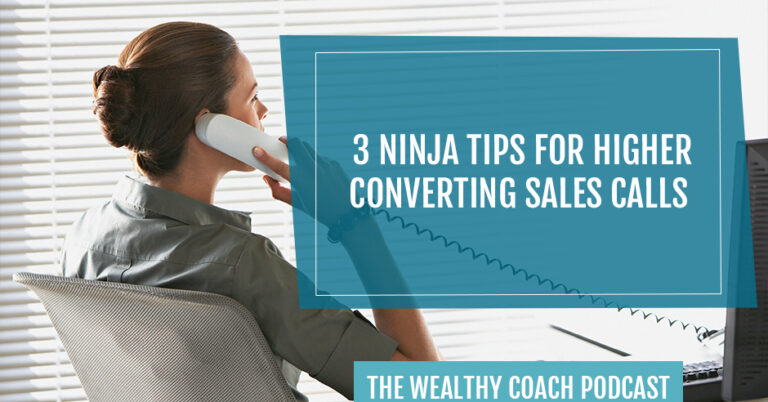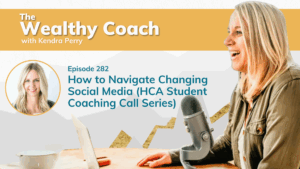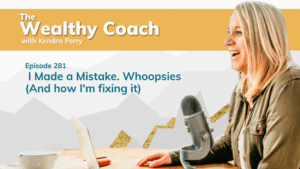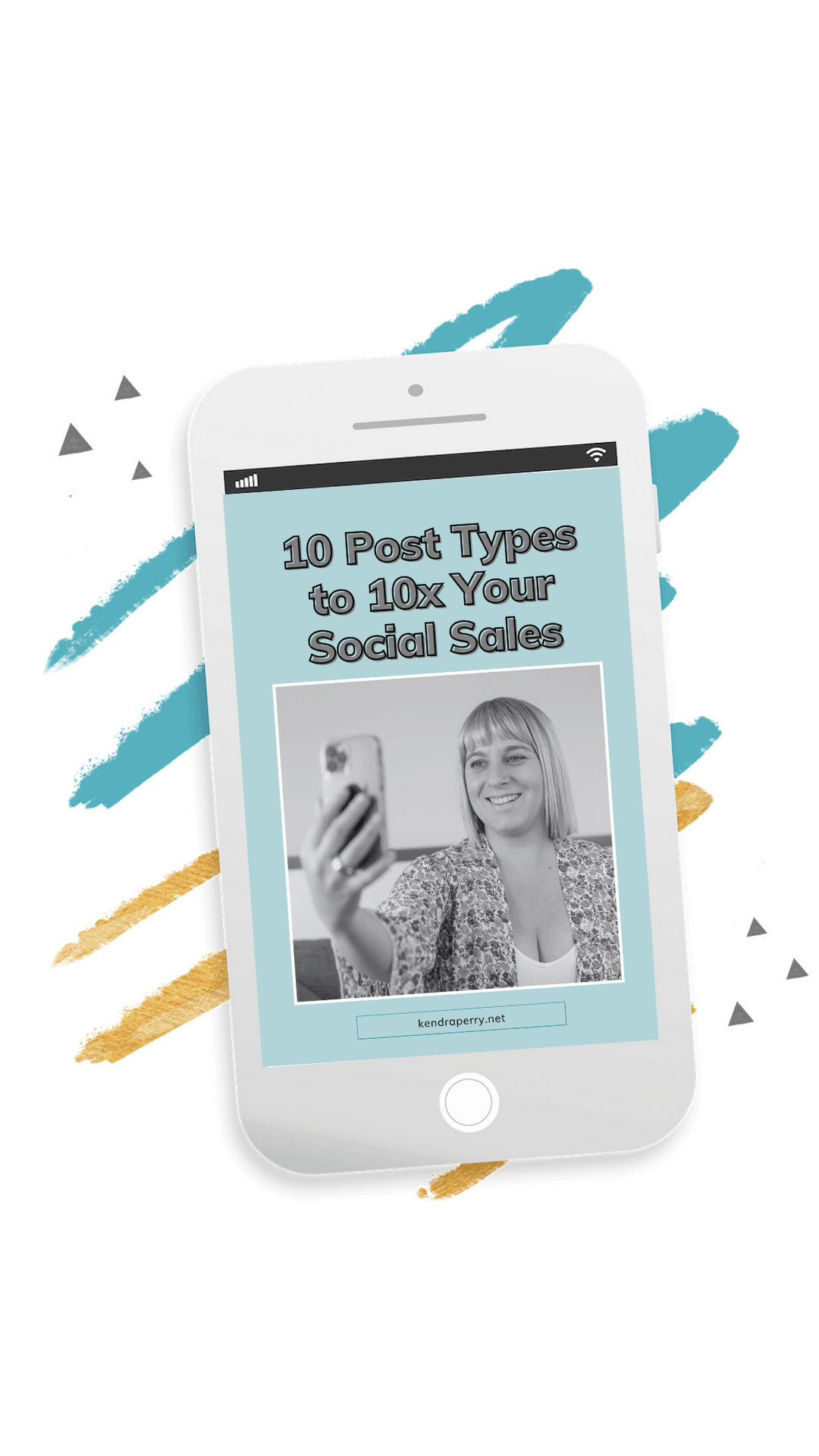Transform your sales calls into conversion powerhouses. Kendra Perry shares three ninja tips that will elevate your sales game and unlock the path to higher conversion rates and business success. Learn how to maximize your sales call potential by setting intentions, active listening, and understanding your prospects’ desires. Join Kendra as she breaks down each of these tips, creating personal connections and showcasing the power of your offers. So don’t miss out on this opportunity to revolutionize your approach and create higher-converting sales calls.
—
Listen to the podcast here
3 Ninja Tips For Higher Converting Sales Calls
What’s up, my friend? Welcome back to the Wealthy Coach. I’m excited that you are here. I hope you are enjoying summer. If you’re one of those Aussies or Kiwis, I hope you’re enjoying your winter. I have to say that I am so grateful right now. If you’re in the East, you’ll know what I’m talking about. Previous to this year, you probably have no idea what I was talking about, but we get smoke. We have a lot of wildfires in the West.
Unfortunately, that is now a phenomenon that has spread to the East. I can’t tell you how many of my eastern friends and colleagues when you guys were having smoke on the East Coast in New York and Toronto were sending me so many photos of smoke. I was like, “I get it. It sucks. Welcome to the party. We’ve been dealing with this for 10 to 15 years.” No one in the East understood until they actually went through it. It turns out it sucks.
Apparently, I’ve been told that in British Columbia, we were having one of the worst wildfire seasons in recorded history. Where I am, you would never know. I cannot tell you how grateful I am. I was looking at the fire map the other day. The whole province is lit up. It’s red, yellow, and orange. There’s high danger everywhere except for this tiny little green bubble, this tiny little green circle in the South and that’s my area. For some reason, we’ve been getting lots of rain, but not too much rain. We’ve had lots of hot weather, but we seem to get a good dumping of rain every few days. We’ve had a few cooler temperatures and that has made all the difference.
Right now, I am trying to take full advantage of the clear skies. I am going on a trip every single weekend. I’m going hiking. I’m going biking. I’m doing whatever I can to enjoy possibly what might be fleeting because you never know when things can change. I honestly love summer so much. It’s been such a sad bummer to see these smoky skies become this commonplace thing because I don’t want to hate summer. I love summer and I love where I live.
When there’s smoke out, you can’t even do anything. It’s a huge bummer so I am grateful. As we’re speaking, we’re getting a little bit of rain. It’s a little cooler. I’m actually in my long tights and a hoodie, which is nice and I can smell that rain. I don’t know if you know that smell of summer rain. I just love it. Anyways, you probably don’t care about this.
Let’s dive into this episode. I want to talk about three tips to lead better sales calls. Sales is a sticky topic. Am I right? A lot of people do not like talking about sales. They are afraid to sell. There are all kinds of feelings, emotions, and avoidance that come with sales. Sales is important because you are a business. If you want to make money online and you have a business, that means you need to make sales. A business that doesn’t make sales isn’t a business. Of course not. It would be a hobby or something you’re just doing for shits and giggles. If you want to have a business, that means you need to make sales.
I want to make sure that we get on a level field here and talk about what is a sales call. What do I mean when I say sales call? I essentially mean a sales conversation. When you hop on the phone with someone who’s interested in investing in your offer and you have a conversation that either leads to a sale or maybe it doesn’t lead to a sale. What a sales call isn’t and this is important, a sales call isn’t an opportunity for someone to get free information from you.
This was a big mistake that I made when I was starting out because I thought, “I’m just going to offer this free consultation. I’m going to get people on the call. I’m going to listen to what they say, then I’m going to tell them all the things that are wrong with them. I’m going to be super smart and prove that I’m this really smart practitioner and impress them, and that is going to make them want to buy from me.” Unfortunately, that often didn’t make them buy from me.
A sales call isn’t an opportunity for people to get free information from you. Why is this? The first thing is a sales call is a lot of your time. It is a huge investment of your time and you cannot give away your time like that for free. You are someone who’s probably putting a lot of content out into the world. Maybe you have a podcast. Maybe you’re doing Instagram lives. You’re on Twitter, Instagram, Facebook, or wherever. You are already giving away a lot of free content.
If people want free content, then there are lots of opportunities for them to consume that content on your social media channels. If you are giving away a free time block of your time, it can’t just be free coaching because that doesn’t sell. It gives people a little bit of information about what they need and makes them think they have enough, but then they go out there and execute it and they don’t get the results. It does them a disservice. You are not a charity. You cannot just give away your time like that for free.
I want to make it clear. When we’re talking about a sales call, the purpose of this call is for a sales conversation. It’s incredibly important in the way that you message this call and talk about this call and promote this call that you are clear that this is not an opportunity to get free information. This is not an opportunity for someone to pick your brain. This is a conversation to see if they are a good fit for your program. That’s really important.
It might be helpful to change even what you call the call or what you name the call. A lot of people will call it a free consultation or a free coaching call. I don’t recommend that because the name itself will make the prospect assume that they are getting free information, and there can be a big disconnect with that.
If you jump on a call thinking you’re just getting this free coaching call, and then the coach tries to sell you into their program, it’s a bit of a disconnect and it can feel misaligned, and then you’re like, “Ooh.” That’s where it feels icky because I thought I was getting free information and now this person is trying to sell me something. You might consider changing the name to an enrollment call or a qualifying call. Some people call it a discovery call. I don’t love that name because what is a discovery call? What even is it?
If you were going to apply for college, you might get on the phone with an enrollment advisor. You are not getting on the phone expecting them to teach you a course or part of one of your courses on the call. You’re jumping on an enrollment call to ask questions about enrolling in the college or university. You might want to think about it like that.
Do you need a sales call? Not necessarily. Not everyone needs a sales call. If you don’t want to have a sales call, then you can figure out how to sell without one. Personally, I don’t use a sales call for either of my programs. Keep in mind that both my programs are mid-ticket. HTMA Expert is $18.97 and goes on promo for $13.97, and HCA is $25.97 and goes on promo for $19.97, at least at the time of this recording. Those are mid-ticket.
Mid-ticket, you can sell without a sales call, but it’s not easy. It’s easier to sell lower-ticket items without a sales call. The higher ticket you get, typically, the more you might need a sales call. A big part of it is that a lot of people need to speak with someone before they’re ready to enroll. It’s scary to make an investment and they want to talk to a human to feel that safety or that security that everyone wants to feel when they put down a big sum of money to invest in something.

The other reason why you might want a sales call is if you are focused on qualifying people. You want to make sure you get the right person into a program. For example, maybe you are doing a higher ticket program and you only take on twelve people at once. Maybe you want to make sure that the person coming into the program has the right personality and the right energy for the program. A small group of twelve people or someone where the energy is off or maybe the personality doesn’t align can actually impact the experience of the rest of your group members. In a situation like that, you might actually want a sales call.
What I will tell you is you can run your business whatever way you want, and however you want. It’s your business. If you don’t want a sales call, then you don’t have to have a sales call. This is how I felt early on. I have put my time in for sales calls. Let me tell you, I have done hundreds of sales calls. I got to a point where I didn’t want to do them anymore. I still don’t want to do them. People told me that I wouldn’t be able to sell anything expensive without a sales call. I said, “F*ck you.” I learned how to do it.
What I will tell you is if you’re going to sell without a sales call, you need strong messaging. Your sales page and your entire sales process is going to need to qualify the prospect. It’s going to need to answer all their questions, address all their objections, and tell them all the details about your program. I’ve invested large sums of money in messaging because I want to make sure that the right person comes into my program. To this day, I’ve never had someone who is the wrong fit come into my program.
Yes, we’ve had people come to the program who maybe were less motivated and didn’t do the work. You can’t always prevent that even with a sales call. Everyone who comes into my program is an early-stage health coach, practitioner, or professional. My copy and my messaging are very clear about who the program is for and who it is not for.
To this day, we haven’t had someone come to the program who was too advanced for the program, or not advanced enough for the program, or wasn’t a health coach, or in the health and wellness space. That’s what you would need in place to sell without a sales call. It’s always going to be easier to sell on the call because what we are doing is we are breaking down energy filters.
I’m off on a bit of a tangent here. I wasn’t planning to talk about all this, but whatever. I’m riffing. I’m raffling. This is where I’m going to go. The screen creates this filter of energy. What I mean by that is it’s really easy to sell in person. You could go do in-person talks, not even be great at sales, and you would probably get clients. I was able to get so many clients from the in-person workshops that I did when I graduated with my health coaching certification. I knew that that was going to be a way to get clients and that is what I did. I was not good at sales.
Looking at what I used to sell, looking back now, I’m like, “I can’t believe that sold.” The reason for that is because there’s no filter. People are in the room with you. They can sense your energy. They see that you’re a real person. You’re not just this talking head. They are there with you and they’re going to vibe with you. Once we put the screen in place, we start filtering out that energy. Maybe I’m on a virtual workshop with people. I’m still there. I’m in person, but I filtered the energy so it’s going to be harder to sell. When we remove that, people aren’t even there in person with me and everything is automated.
For example, I sell right now through an automated webinar primarily. That’s going to be even harder for people to connect. The conversion keeps going down. A good sales call conversion is about 30%, but my HCA students usually close at about 50% to 60%. It’s sometimes higher. We’ve had one student closing as high as 93%, which is crazy. I used to close around 75% because when you have good marketing, it’s easier to close. When you understand how to lead an effective sales call, it’s easier to close. On a live webinar, I typically close at about maybe 5% to 10%. On an automated webinar, I close at about 2%.
I hopefully can see how the conversion goes down significantly as we start filtering our energy and get more disconnected from the prospect. It will always be easier to sell on a sales call, but that doesn’t mean that you need one. I just want to put that out there. I hate to be the coach who says, “You absolutely need to do this and you can’t do this.” I truly believe you can. There are so many different ways to run a business and you can do it however you want. You just have to figure out what works for you and make sure that what you’re doing makes sense.

I’m on a tangent, but I’m going to keep going with this and roll with it. For example, if you’re brand new and you’ve never sold before, then it may not be a good idea to just set up an evergreen webinar because you have no sales skills. A good sales conversion on an evergreen webinar is 2%. That’s a good sale. That’s someone who knows what they’re doing and has good messaging. You’re probably not going to get that 2%. For a lot of us, it usually makes sense to start with a sales call. That being said, you hate sales calls and you are like, “I’m never going to like these. I hate them. I don’t want to do them.” You can learn how to sell without one.
Ninja Tip #1: Set the Intention
Let’s get into the content of this episode now that I have stepped down humbly from my soapbox. My first tip for leading a more effective sales call is to, number one, set the intention. What do I mean by that? We have to imagine. I’m going to call it the prospect. This is the potential client. When they jump on the call with you, they probably feel a little bit nervous. Maybe they’re a bit contracted. They’re a little bit hesitant because they may have never done this before. They have no idea how the call is going to go. They don’t know if you’re going to be asking them tons of questions or what information they’re going to have to divulge.
We know in health and wellness and personal development, it’s very personal. People might be jumping on to talk about their periods, their infertility, their poop problems, and things that are embarrassing and maybe they’re not overly comfortable talking about. The first thing we always want to do is we want to set them at ease. We want to make them feel relaxed because a more relaxed person is going to talk more. You’re going to learn in the next step that talking more is a good thing.
By setting the intention, what I recommend that you do is tell them exactly how the call is going to go. That is going to put them at ease. Just an example, you could say, “Jane, my intention for this call is to learn a little bit more about why you booked this call with me today. I want to ask you some more questions about the application you submitted. I want to determine if I can help. If after talking to you, I feel like I can help you, I’m going to tell you a little bit more about my XYZ program and we’ll talk about the pricing and the logistics, and we’ll go from there. Does that sound good?”
Hopefully, you can see what I just did there. I told the prospect the entire rundown of the call. I said exactly what my intention was. I want to ask you questions, learn more about why you’re here today, see where you are now, and where you want to go, and then I’m going to determine if I can help. You’re then telling them that you’re going to pitch to them. You’re going to say, “If it feels like I can help you, then I’m going to tell you a little bit more about my program, the logistics, and the pricing.”
I love this because you’re basically saying, “I’m going to pitch to you if I feel like I can help.” You are essentially asking for their permission to pitch. I always finish that with that permission-based question, “Does that sound good?” If they say that sounds good, that should also put you at ease because they’ve just given you permission to pitch.
On top of that, maybe you also notice that I talked about the money right off the bat, “We’re going to talk about pricing.” I like to seed in the money right away because then, I’m being transparent that I’m going to tell you about my offer and the offer costs money. Hopefully, they already know that by now because they’ve been following you. They’ve learned about your program and they understand that it’s a paid program. I always like to seed in the money as quickly as possible. Set the intention. Don’t just start asking them questions. Put them at ease by showing them exactly how the call is going to go.
Ninja Tip #2: Talk Less, Listen More
Step number two is to talk less and listen more. This is really important. Effective sales is not about talking. That should hopefully make you feel a little better because the goal is to talk less and listen more to the prospect. I’m looking at a blog from HubSpot right now. HubSpot had some artificial intelligence go through all their sales calls to try to determine what were the measures of an effective sales call. They determined that the ideal talk-to-listen ratio is 43:57. Talk 43% of the time and listen 57% of the time. Hopefully, you can see that the goal is to talk less.

What this AI also determined is that most of the sales reps spoke about 65% to 75% of the time. This was a big reason why my early sales calls weren’t effective because I was spending so much time doing all the talking, trying to prove how smart I was, and blabbing on about adrenal fatigue, the HPA axis, thyroid, etc., and I wasn’t actually listening. I truly believe that effective sales is mostly about listening. I recommend to my HCA students that they only talk 25% of the time. I recommend a much lower ratio in that regard because what I’ve seen is that the less that we talk, the better that we sell. This will give you better results if you can talk less.
How do we talk less? We allow the prospect to share their story and talk about their experience. We can allow that to happen by asking more questions. What we want to do is we want the prospect to get this beautiful space to share their story, and to talk about their struggle in a way that they may have never had the opportunity to do before. By doing that, not only are you giving them this beautiful platform, but you’re showing them what it’s like to work with you. I believe a very effective coach or a powerful coach asks a lot of questions and holds a lot of space.
If you were to enroll in HCA, you would instantly get access to my 100K sales script. This is an incredibly effective script. Honestly, that whole script is worth the cost of the program alone. I used to sell the script for $1,500 because that’s how good it is. When you go through the script, you’ll be fascinated by the fact that you’re not talking a lot. You’re mostly just asking questions and listening. The more that you talk, the less effective your sales call is going to be.
I hope that takes the pressure off because then it’s not about, “What do I say? How do I do this?” It’s like, “I’m going to show up. I’m going to give this person a platform to share their story and their experience with me. I’m going to hold space for them. I’m going to ask questions, and then we’re going to move into the sales process.” It definitely takes the pressure off.
The other thing that’s great about listening more is that’s what allows you to qualify the prospect. You can hear their story, experience, and goals, what they’re looking for, and what they’re hoping to get out of working with you. You can determine, “Is this person someone I can help?” When you listen, what you might find out is maybe someone is not the right fit for you.
I can remember one sales call in particular where the woman came on and she told me all about her story. I was thinking, “This sounds right in line with what I do. It sounds like I can help. ” I asked her, “What are you hoping to get out of working with me?” She said, “I want a specific diagnosis and I want specific recommendations based on my specific diagnosis.” That’s when I knew I couldn’t help her because I was an unlicensed health coach. I don’t diagnose, treat, or cure. That was way outside my scope. I simply told her, “Based on what you just said, I’m not the right person to help you. Legally, I can’t help you with that. Here is a practitioner who could,” and I referred her and sent her on her way.
Ninja Tip #3: Weave Their Desires Into Your Program Pitch
When we talk less and listen more, not only do we allow the prospect this beautiful opportunity to share their story, but we also get the information we need to qualify the prospect and determine, “Are they the right fit to work with us?” That’s number two. Number three is to take notes and weave their desires into your program pitch. A lot of people ask me whether they should run a sales call over the phone or on Zoom video. I’ve done both. Personally, I prefer to have the video turned off because I like to take notes. I find that when I have video turned off, I’m less distracted. I can literally close my eyes and deeply listen to the person.

Maybe you prefer video. It’s totally up to you. I didn’t find there to be a difference. Regardless, you should take notes. If you’re taking notes and you’re on video, let the person know you’re going to take notes, “I’m going to take notes so I don’t forget anything we talked about. If you see me looking down and typing, I’m paying attention. I’m just taking notes.” I always like to let people know that. It’s important that when you are talking less and listening more, a question that you ask them is, “What do you want to see going right? Ideally, what do you want to see happen?” These are good questions to ask. Pay attention to what they say their struggles are, what they’re struggling with, and what they want to learn about that sort of thing.
When you pitch your program, you want to be intentional with how you explain it to them. What do I mean by this? I’m going to use an example. Let’s say we have Susie. Susie is an early-stage health coach. She wants to build her business, but she hasn’t been able to get clients. She’s like, “I’m confused about what my niche should be. I keep going back and forth on whether should it be this. I don’t know if I’m niche enough, but I’m afraid to niche down too much. I’m confused about that.” Maybe she says that. Maybe she says, “I want to learn how to properly use social media because I don’t love social media. I don’t want to have to spend any more time than I need to on it. I want a good strategy that engages my audience and helps them become clients.”
Let’s say she says something like that. When I am telling Susie about Health Coach Accelerator, my program, I can say something like, “Susie, I’m going to tell you a little bit more about Health Coach Accelerator. In Module One, we go through niching and messaging. Do you remember how you said you were really confused about your niche and you couldn’t decide if you were too niched or not enough niched?” She’ll say yes. I’ll be like, “That’s what we’re going to go through in Module One. I’m going to give you everything you need to know to implement my three-step profitable niche framework so that you can choose a niche that is perfectly niched. It’s not going to be too niched. It’s not going to be too general. You’re going to feel positive about your niche at the end of Module One.”
Hopefully, you see what I just did there. I didn’t go into, “We’re going to go through this and then we’re going to talk about this, and we’re going to go to this and this.” I took what she said and I weaved it into the program pitch. Maybe I’m talking to her about our module on content and social media. I’m saying, “Susie, in Module Six, this is where we go through content creation and social media. Remember how you said, you had no idea what you were doing on social media? By the end of Module Six, you’re going to know exactly what you’re doing on social media because you’re going to get an entire content calendar that tells you exactly what to post and when to post it, and how to post it.”
See what I just did there? I weaved her desire and her struggle into my program pitch. Focus on what they say they’re struggling with and what they say they want to learn about or they want to have. If it is relevant to your program, you weave that in when you make your program pitch. When you do this, essentially what you’re doing is you’re making the prospect believe that the program was designed specifically for them because it is.
If you’ve gotten to this point of the call, you’ve determined they’re the right fit. They are a targeted niche-specific client and your program should be made exactly for them. This is why we want to talk less and listen more so we can hear what they’re saying, and then we can weave their struggles and desires into our program pitch. I think it’s juicy.
Let’s quickly recap that. The number one tip to lead a more effective sales call is to set the intention. Put the prospect at ease by breaking down exactly how the call is going to progress. Number two, we want to talk less and listen more. Remember that 43:57 ratio. We want to at least get that, but I recommend that you go even lower and try to get your talking down to 25%. Number three, we want to take notes as we’re listening and learning. We want to weave their desires and their struggles into our program pitch. Not too bad, right?
I hope this has taken the pressure off a little bit about sales. Hopefully, what you’ve learned is sales isn’t about proving yourself. It isn’t about doing all the talking. It’s about active listening and holding space. Not so bad. All right, my friend, I hope you have enjoyed this episode. If you love this show and you want to support me, you can do a very simple thing by making sure you’re subscribed, hitting download on the last three episodes. If you want to go one step further, I would absolutely love it if you would give the show a five-star review on iTunes. You can go to RateThisPodcast.com/wealthy. I will see you next Monday, same place, same time, where I help you become wealthy AF.
Important Link






